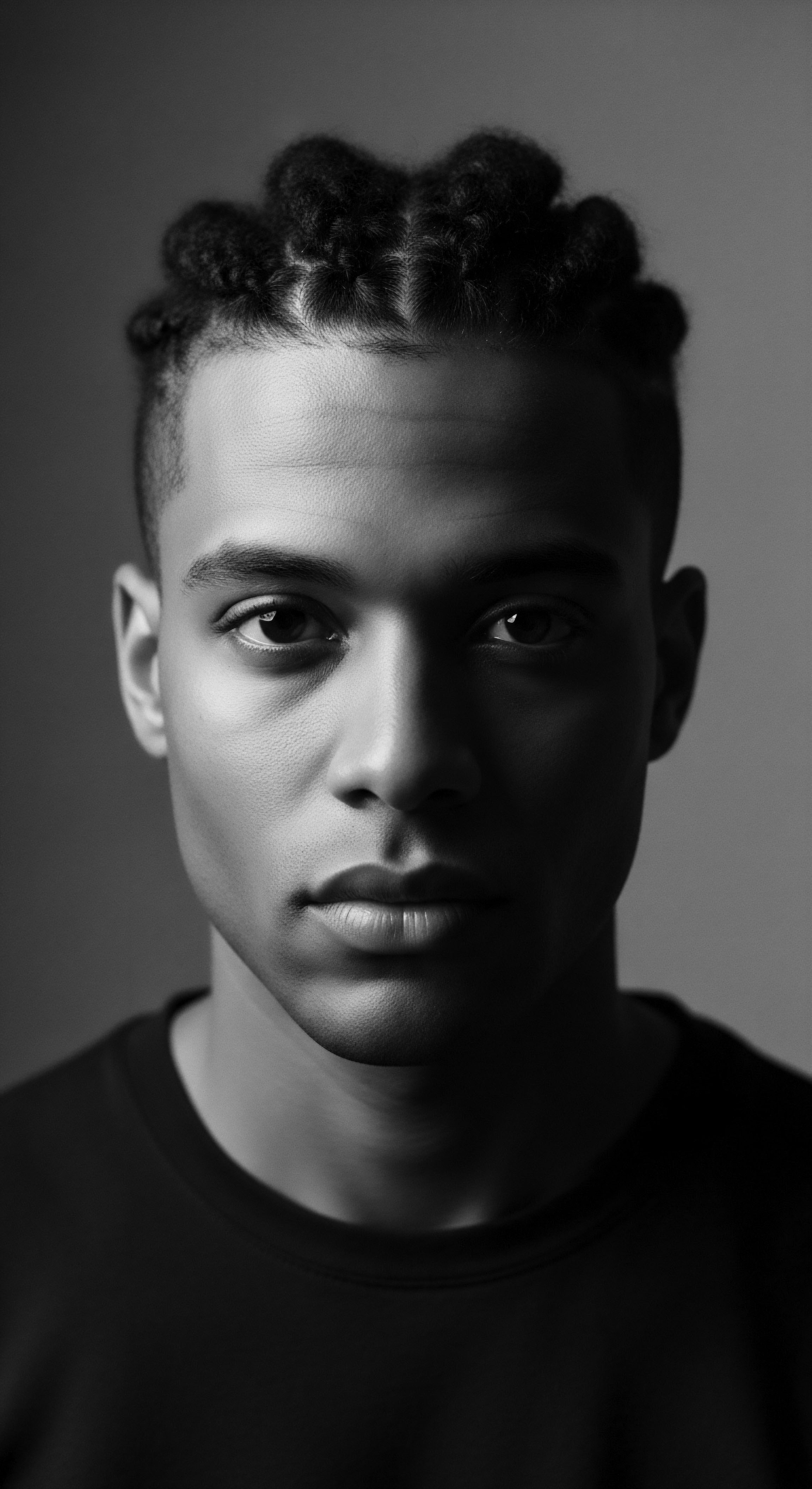
Fundamentals
The intricate dance of life’s processes, from the soil that feeds our sustenance to the very strands that crown our heads, operates within a delicate balance. At the core of this balance, in the realm of hair care, lies the concept of pH. This measure, the Potential for Hydrogen, quantifies the acidity or alkalinity of a substance, existing along a numerical continuum from 0 to 14. A value of 7 signifies neutrality, the harmonious midpoint.
Numbers below 7 indicate acidity, with 0 representing the apex of acidic strength, while values exceeding 7 denote alkalinity, reaching its peak at 14. For textured hair, understanding this fundamental principle is akin to listening to an ancient whisper, revealing truths about its innate fortitude and how it thrives best.
Natural hair and the scalp maintain a slightly acidic environment, typically resting within a pH range of 4.5 to 5.5. This slight acidity is not accidental; it is a meticulously crafted shield, a profound layer of biological defense. This condition, often referred to as the Acid Mantle, protects the hair’s outermost layer, the cuticle. A healthy, intact cuticle lies flat, forming a smooth, protective sheath around the hair shaft.
This alignment contributes to the hair’s inherent sheen, its resistance to snagging, and its capacity to retain precious moisture. When this natural pH is disturbed, particularly by exposure to highly alkaline substances, the cuticle scales lift, leaving the hair vulnerable, porous, and susceptible to breakage.
The natural pH of textured hair, residing within a slightly acidic range, safeguards the cuticle and promotes vitality.
Considering the heritage of textured hair, this elemental understanding finds echoes in ancestral practices. Long before the advent of modern chemistry, communities across the African diaspora intuitively understood the importance of balance in their hair care. They observed how certain plant extracts, clays, and natural preparations contributed to hair resilience and luster.
These traditions, passed through generations, often leveraged ingredients that subtly aligned with the hair’s natural acidic state or provided restorative properties following more alkaline cleansing rituals. The wisdom was embedded in the practice, a silent knowing of what truly nourished the strands.
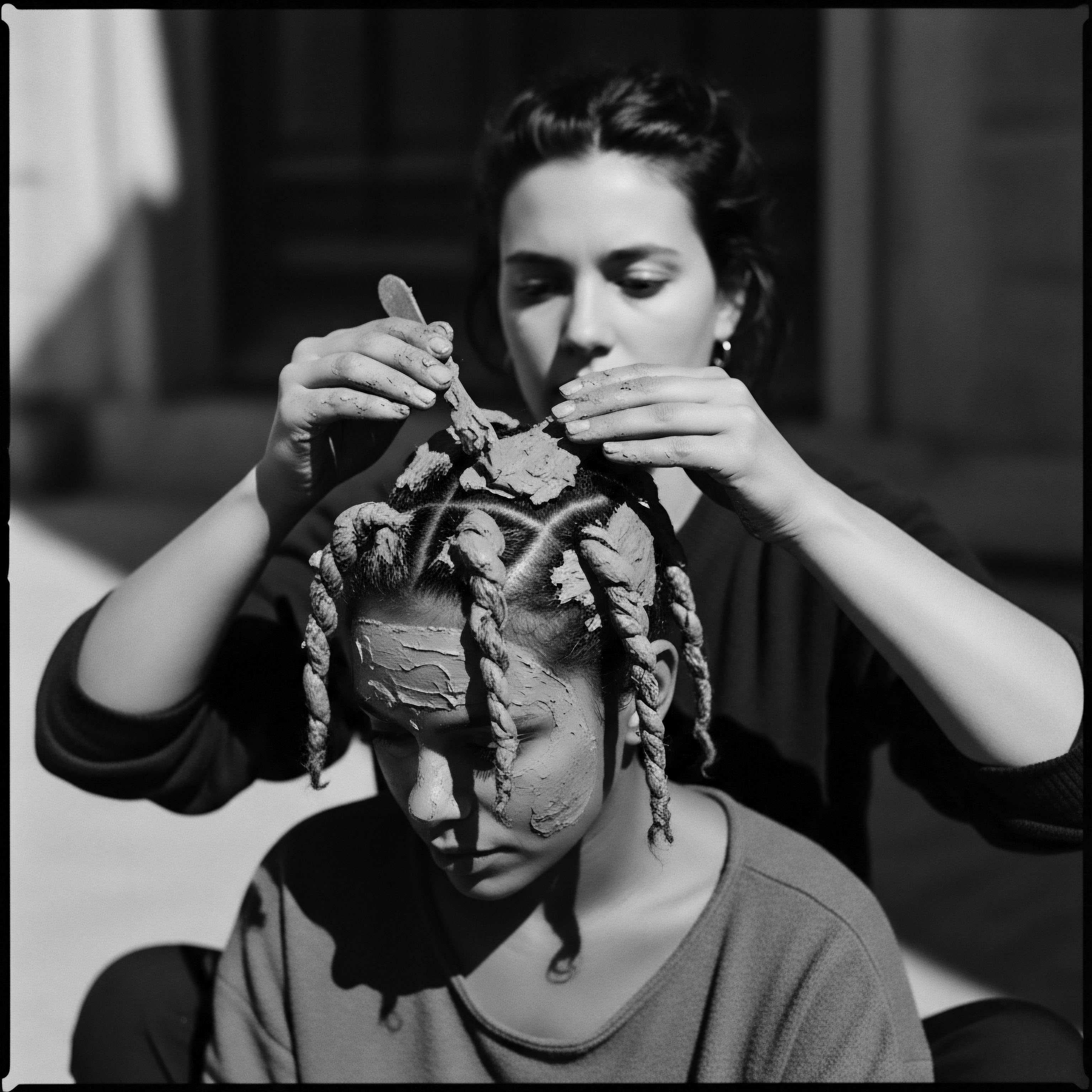
The Scale of Life’s Balance
Grasping the pH scale offers a lens through which to view the very integrity of our hair. It is a spectrum of chemical environments, each with its own capacity to influence the structural components of the hair strand. On one end, strong acids can contract the hair shaft, sometimes causing it to harden, while on the opposing end, potent alkaline substances prompt the hair to swell and soften. Navigating this spectrum thoughtfully becomes paramount for maintaining the health and resilience of textured hair, a crown historically subjected to both environmental and human-made stressors.
The outermost layer of the hair, the cuticle, acts as a primary barometer for pH variations. When the cuticle is smoothed and sealed by an acidic environment, it reflects light uniformly, contributing to hair’s natural glow. Conversely, an alkaline environment causes the cuticle to lift, scattering light and revealing the hair’s inner vulnerability, which can manifest as dullness, tangling, and a propensity for damage. The aspiration for robust, radiant textured hair is thus inextricably linked to respecting and maintaining its natural pH.
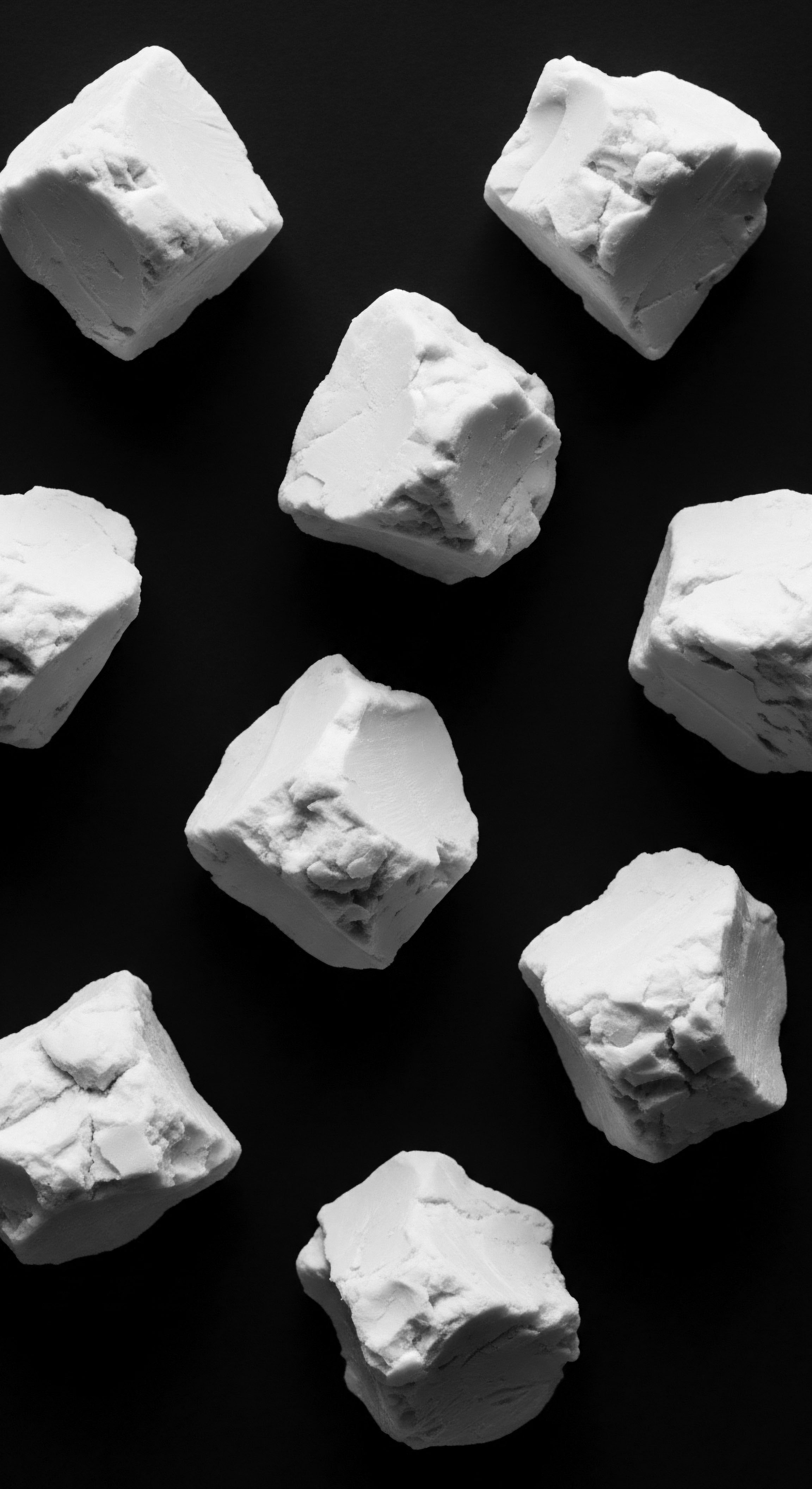
Hair’s Intrinsic Harmony
The inherent slight acidity of healthy hair is not a mere scientific observation; it is a fundamental aspect of its design for optimal function. This acidic pH aids in sealing the cuticle, preventing moisture loss and protecting the inner cortex from external aggressors. It also deters the growth of certain microorganisms that thrive in more alkaline conditions, promoting a balanced scalp microbiome. For centuries, ancestral hair care rituals, often featuring ingredients derived directly from the earth, inadvertently contributed to this natural harmony, guiding practices towards products that supported the hair’s innate protective mechanisms.
Consider the scalp, the foundation from which our hair grows. Its own acid mantle, a thin, protective film of sweat and sebum, also thrives in this slightly acidic range. A balanced scalp pH mitigates conditions like excessive dryness, flakiness, or irritation. When this delicate equilibrium is respected, the entire hair system—from follicle to tip—is better positioned for sustained vitality.
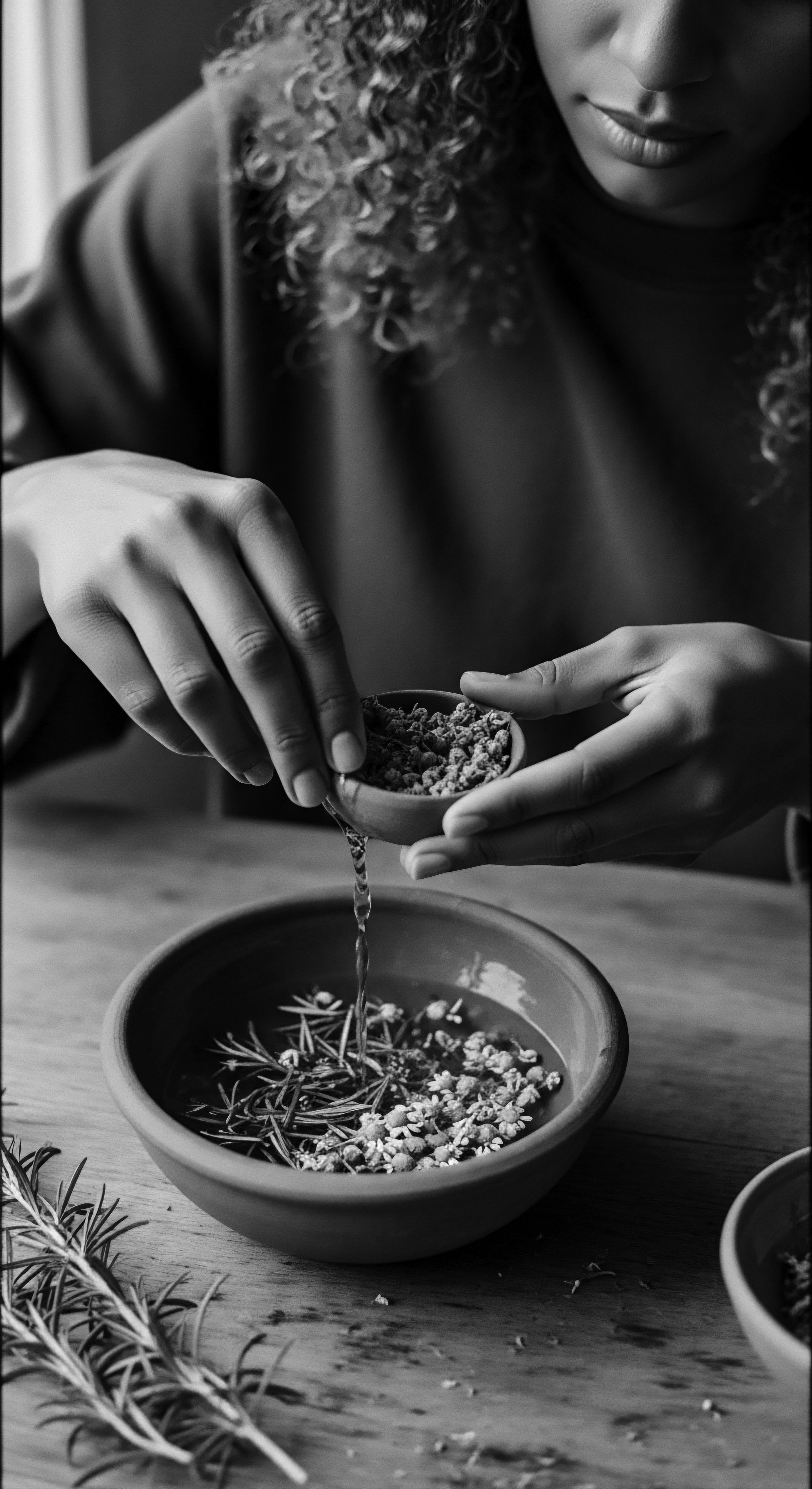
Intermediate
Moving beyond the foundational understanding of pH, we acknowledge its profound significance for textured hair, a hair type characterized by its unique coiled, curled, or kinky patterns. These distinct structural formations mean that natural oils, or sebum, struggle to travel down the hair shaft as readily as they might on straighter strands. This inherent characteristic often leaves textured hair predisposed to dryness. The interplay between pH and moisture retention thus becomes a central consideration in its care, a silent language spoken between strand and substance.
In ancestral traditions, the wisdom of maintaining moisture was often channeled through generations-old remedies. These practices, honed over centuries, frequently involved ingredients that provided both cleansing and conditioning without stripping the hair of its vital moisture. Many traditional African hair care practices, for instance, involved herbal rinses and natural butters. The pH of these preparations, while not chemically measured with modern tools, was often intuitively balanced through observation and experience, reflecting a deep respect for the hair’s well-being.
Traditional hair care practices often intuitively supported the hair’s pH, prioritizing moisture retention for textured strands.
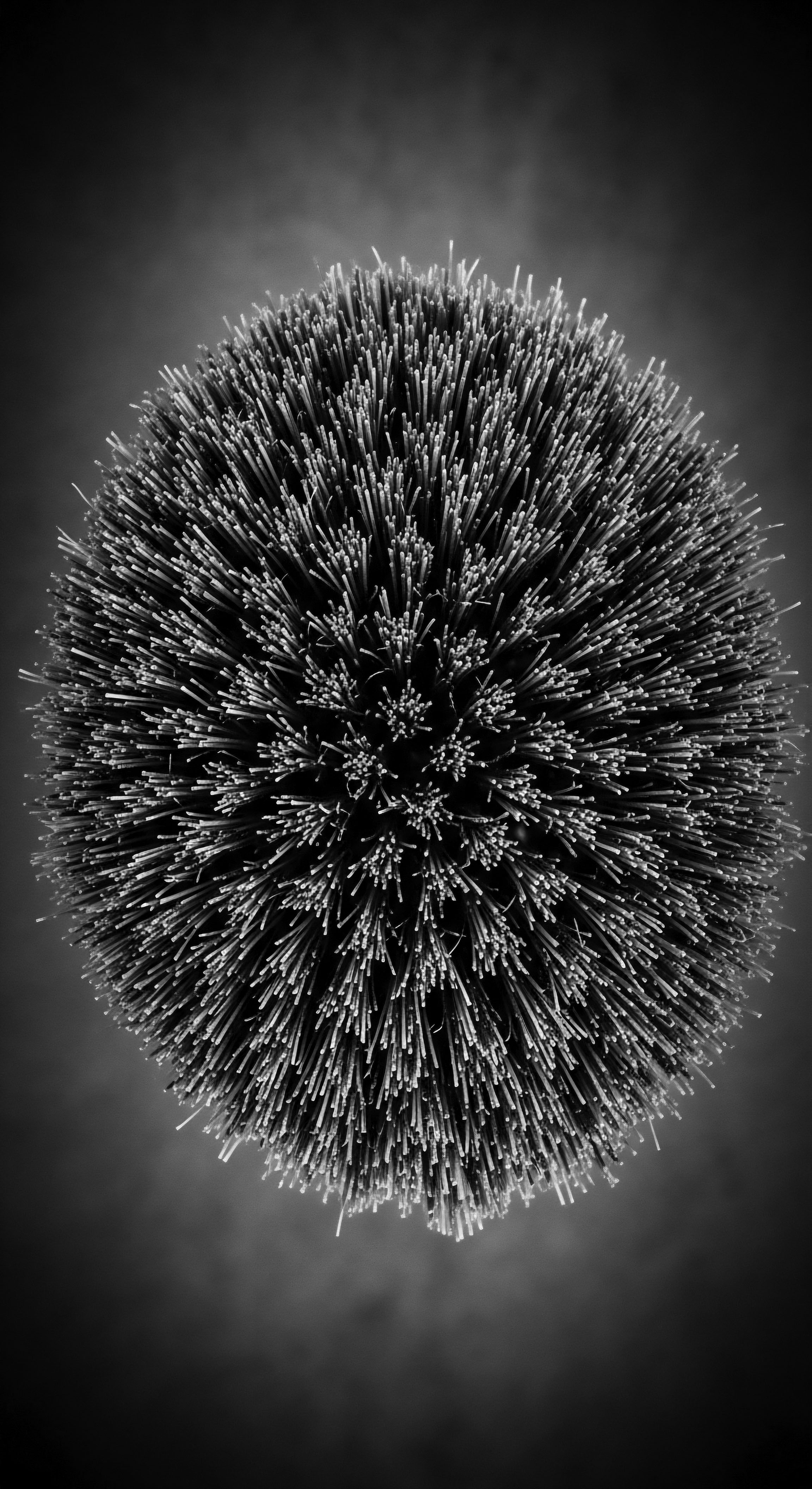
Ancestral Remedies and PH Wisdom
Across the diverse landscapes of Africa and throughout the diaspora, a rich legacy of hair care wisdom unfolded, long before the scientific understanding of pH became widespread. These ancestral practices often centered on natural elements, chosen for their perceived effects on hair strength, growth, and sheen. While the term ‘pH’ was absent from their lexicon, the efficacy of ingredients like certain clays, herbal infusions, and plant-based butters implicitly acknowledged the hair’s delicate chemical balance.
For instance, African Black Soap, a traditional cleanser from West Africa, is a profound example. Crafted from ingredients such as cocoa pods, plantain skins, shea butter, and palm kernel oil, its pH can range from 7 to 10, or even 8.0 to 10.0, and 9-9.5, depending on the specific formulation and preparation. While it provides deep cleansing, its alkaline nature means traditional users often followed with moisturizing agents or acidic rinses. This intuitive understanding of ‘cleansing and then restoring’ mirrors modern scientific principles of pH balancing.
Other traditional rinses and ingredients, often more acidic, played a crucial role in re-sealing the cuticle after cleansing. For example, Chebe powder, used by women in Chad, is celebrated for its ability to increase hair thickness and retain moisture, and it is also noted for its potential to help balance scalp pH. Similarly, Ambunu, a leafy plant from Chad, has been traditionally used as a gentle cleanser and detangler, creating a ‘slip’ that aids in manipulation, and it is known for its saponin content which provides mild cleansing properties.
Consider also the application of various oils and butters, such as Marula Oil from Southern Africa or the widespread use of Shea Butter. These emollients, typically acidic or neutral, helped to lay down the cuticle, lock in moisture, and provide a protective barrier against environmental elements. The generations of knowledge concerning which plants yielded the best results, and how they should be combined or applied, was a testament to a deep, embodied understanding of hair’s needs.

The Chemistry of Curl Integrity
The structural integrity of textured hair, with its unique coils and curves, is particularly susceptible to pH imbalances. When the hair’s pH rises too high, becoming excessively alkaline, the delicate disulfide bonds that shape the curl pattern can be compromised, leading to a loosening of the curl and an increased risk of breakage. The hair shaft swells, its cuticles lift, and its protective barrier weakens, making it prone to dryness and external damage.
Conversely, maintaining an appropriate pH helps to keep the cuticle scales tightly closed, which is paramount for preventing moisture loss in hair types already prone to dryness. This closed cuticle surface also minimizes friction between strands, reducing tangling and preserving the definition of coils. A thoughtful approach to pH in textured hair care is not merely about science; it is about preserving the inherent beauty and resilience of each individual strand, honoring its natural form.
| Traditional Ingredient/Practice African Black Soap |
| Observed PH Characteristics (Approximate) Alkaline (pH 7-10) |
| Connection to Textured Hair Heritage A staple West African cleanser, often balanced with subsequent moisturizing steps. Its use reflects an early understanding of cleansing power. |
| Traditional Ingredient/Practice Chebe Powder (Chad) |
| Observed PH Characteristics (Approximate) Can help balance scalp pH |
| Connection to Textured Hair Heritage Renowned for moisture retention and length, used traditionally by Basara women, showing care beyond simple cleansing. |
| Traditional Ingredient/Practice Ambunu (Chad) |
| Observed PH Characteristics (Approximate) Gentle cleansing properties, natural saponins |
| Connection to Textured Hair Heritage A traditional herbal cleanser and detangler, providing 'slip' without harsh stripping, aligning with a desire for gentle care. |
| Traditional Ingredient/Practice Herbal Rinses (e.g. Rooibos tea) |
| Observed PH Characteristics (Approximate) Often mildly acidic to neutral |
| Connection to Textured Hair Heritage Used for shine, antimicrobial properties, and as final rinses, supporting cuticle closure and scalp health. |
| Traditional Ingredient/Practice Natural Butters/Oils (e.g. Shea, Marula) |
| Observed PH Characteristics (Approximate) Acidic to neutral |
| Connection to Textured Hair Heritage Historically applied for moisture sealing, conditioning, and protection, reinforcing the hair's natural barrier. |
| Traditional Ingredient/Practice These ancestral practices, while not framed in modern chemical terms, reveal an intuitive wisdom regarding hair's needs and its interaction with natural compounds. |

Academic
The academic elucidation of Textured Hair PH transcends a simple numerical definition; it is a profound examination of the biophysical and chemical interactions that govern the health, integrity, and very identity of hair with distinct curl patterns. This domain of inquiry requires an understanding of the hair strand’s intricate architecture, from its protective cuticle layers to the inner cortex, and how these structures respond to changes in hydrogen ion concentration. The Clarification of Textured Hair pH demands a nuanced perspective, recognizing that the ideal slightly acidic range of 4.5 to 5.5, while universal for healthy hair, holds particular resonance for textured strands due to their inherent structural vulnerabilities and historical experiences with disruptive chemical treatments. This intellectual exploration of Textured Hair pH, as a concept, extends into examining how environmental factors, ancestral practices, and modern innovations have shaped its meaning and significance through time.
The hair shaft, primarily composed of keratin protein, possesses specific chemical bonds that dictate its form and strength. The outermost layer, the cuticle, is comprised of overlapping scales that function akin to shingles on a roof, providing defense against physical and chemical harm. When the hair’s environment becomes highly alkaline, typically exceeding a pH of 7, these cuticle scales lift, exposing the more vulnerable inner cortex.
This phenomenon significantly increases the hair’s porosity, leading to rapid moisture loss, increased friction between strands, and heightened susceptibility to mechanical damage, manifesting as brittleness and breakage. An alkaline shift can also disrupt the hair’s disulfide bonds, which are critical for maintaining its structural integrity and curl pattern (Robbins, 2012).

The Biophysical Architecture of Textured Hair
The unique morphology of textured hair — ranging from waves to tightly coiled patterns — presents distinct challenges and characteristics when considering pH. The helical twists and turns in the hair shaft mean that the cuticle layers are not uniformly flat along the entire length of the strand. This inherent structural quality can lead to naturally raised cuticle scales in certain areas, making textured hair inherently more susceptible to moisture loss and protein degradation when exposed to harsh chemical environments. A comprehensive Description of Textured Hair pH, therefore, must account for this intrinsic vulnerability, underscoring the critical need for products and practices that support cuticle integrity.
Furthermore, the uneven distribution of natural sebum along a coily strand, due to its curvilinear path, leaves the distal ends more prone to dryness. This dryness is exacerbated when alkaline products cause further cuticle lifting, accelerating moisture evaporation. The chemical Elucidation of Textured Hair pH involves understanding how the hair’s inherent structure interacts with varying pH levels, influencing its porosity, elasticity, and overall resilience. This area of study is crucial for designing care regimens that truly support the unique requirements of textured hair.

The Caustic Legacy ❉ Relaxers and the PH Precipice
Perhaps no single factor has more profoundly underscored the critical Significance of pH for textured hair than the pervasive use of chemical hair relaxers within Black and mixed-race communities. These formulations, designed to permanently straighten highly coiled strands, operate at intensely alkaline pH levels, dramatically altering the hair’s natural structure. Early relaxers, often termed ‘lye’ relaxers, typically contained sodium hydroxide, a potent alkali.
These products operate at an extreme pH range, often between 12 and 14. This is a level of alkalinity comparable to that of drain cleaner, profoundly corrosive to biological tissue.
The profound alkalinity of these relaxers intentionally breaks the hair’s disulfide bonds, a process known as lanthionization, fundamentally reshaping the curl pattern. While this process achieved the desired aesthetic of straight hair, it often came at a severe cost to hair health and scalp integrity. The corrosive nature of such high pH levels leads to extreme swelling of the hair shaft and severe lifting of the cuticle, leaving the hair significantly weakened, prone to breakage, and permanently altered.
Even ‘no-lye’ relaxers, which substitute sodium hydroxide with other alkaline agents like calcium hydroxide or guanidine hydroxide, still operate at highly alkaline pH levels, typically ranging from 9 to 11. While marketed as milder, these products still carry significant risks, as evidenced by the formation of calcium deposits on the hair shaft that can lead to increased dryness and decreased moisture absorption. The historical application of these powerful chemicals represents a complex chapter in textured hair heritage, intertwined with beauty standards and societal pressures.
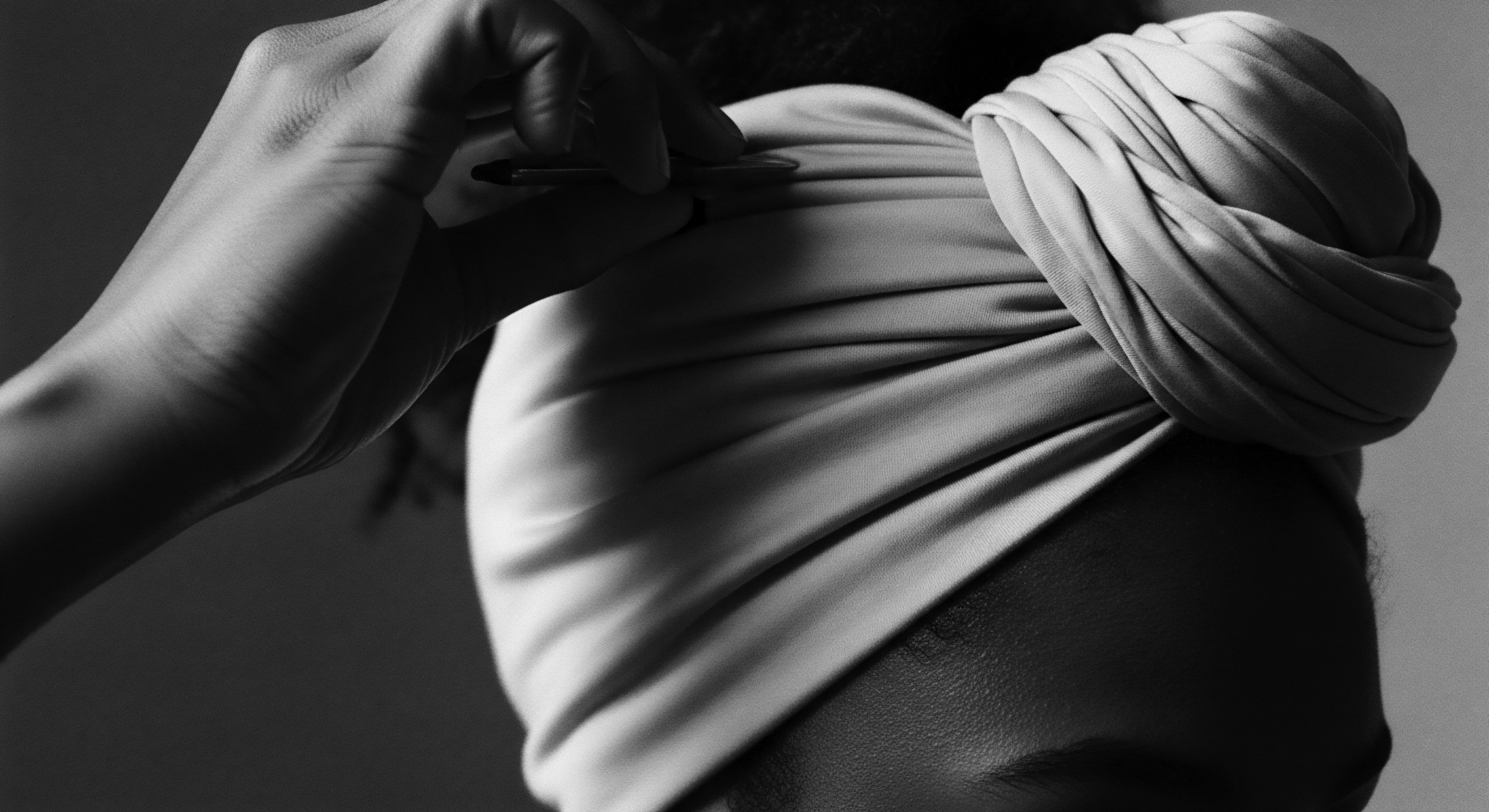
Echoes of Disruption ❉ CCCA and the Quest for Healing
The long-term consequences of chemically altering hair’s pH, particularly through relaxer use, are starkly evident in conditions like Central Centrifugal Cicatricial Alopecia (CCCA). This scarring alopecia, defined by progressive, permanent hair loss, disproportionately affects women of African descent, initiating at the crown and expanding outwards. While CCCA’s etiology is multifactorial, encompassing genetic predispositions and various traumatic hair practices, the role of chemical relaxers and their extreme pH cannot be understated.
A groundbreaking study by Sishi, Van Wyk, and Khumalo (2019) illuminated this perilous connection. Their research revealed that the median pH of all hair relaxers tested, including those marketed for children, was 12.36 (interquartile range 12.10 – 12.62), a level categorized as corrosive to the skin. The study further noted that an overwhelming majority — 91% of sodium hydroxide relaxers for adults and 67% of those for children — were sold without neutralizing shampoo.
This lack of immediate neutralization exacerbates the prolonged exposure of the scalp and hair to highly alkaline chemicals, potentially contributing to the high prevalence of alopecia among women with Afro-textured hair. The implications are profound, suggesting that practices rooted in historical pressures for hair conformity have led to tangible dermatological consequences, a stark reminder of the body’s enduring wisdom and its limits.
The narrative around Textured Hair pH thus evolves from a purely scientific concept to a deeply cultural and historical one, reflecting periods of forced assimilation and the subsequent reclamation of ancestral beauty. Understanding this pH dynamic is not merely about product selection; it is about acknowledging a legacy of resilience, resistance, and the ongoing pursuit of holistic hair wellness that honors the inherent dignity of textured strands.
- Sodium Hydroxide (Lye) Relaxers ❉ These are typically stronger, reaching pH levels between 12 and 14, acting rapidly to break disulfide bonds in the hair.
- Calcium Hydroxide (No-Lye) Relaxers ❉ While often perceived as milder, these still operate at a high pH, generally between 9 and 11, and can lead to drying calcium deposits on the hair shaft.
- Ammonium Thioglycolate (Thio Relaxers) ❉ Used in some formulations, these also break disulfide bonds, though the process is different from hydroxide relaxers, with a pH usually around 10.
| Substance/Hair Type Healthy Textured Hair & Scalp |
| Typical PH Range 4.5 – 5.5 (Slightly Acidic) |
| Impact on Hair & Scalp (Heritage Context) Maintains cuticle integrity, retains moisture, and provides a natural protective barrier; represents hair in its most resilient, ancestral state. |
| Substance/Hair Type Traditional African Black Soap |
| Typical PH Range 7.0 – 10.0 (Alkaline) |
| Impact on Hair & Scalp (Heritage Context) Effective cleanser but necessitates subsequent acidic rinses or rich moisturizers to restore pH balance and prevent dryness, as understood through generations of practice. |
| Substance/Hair Type Lye Relaxers (Sodium Hydroxide) |
| Typical PH Range 12.0 – 14.0 (Highly Alkaline) |
| Impact on Hair & Scalp (Heritage Context) Severely disrupts hair's disulfide bonds, permanently altering curl pattern; historically associated with scalp burns, breakage, and conditions like CCCA. |
| Substance/Hair Type No-Lye Relaxers (Calcium Hydroxide) |
| Typical PH Range 9.0 – 11.0 (Alkaline) |
| Impact on Hair & Scalp (Heritage Context) Though often seen as less harsh, still significantly alkaline; can lead to dryness and mineral buildup, continuing a legacy of chemical alteration with potential adverse effects. |
| Substance/Hair Type The stark contrast between hair's natural pH and that of chemical relaxers highlights the historical tension between cultural assimilation and hair health within Black and mixed-race communities. |

Reflection on the Heritage of Textured Hair PH
The journey through the meaning of Textured Hair pH is more than a scientific inquiry; it is a profound meditation on heritage, care, and the enduring spirit of Black and mixed-race hair traditions. From the intuitive wisdom of ancestral hands, recognizing the balance inherent in nature’s offerings, to the stark realities brought forth by chemical interventions, the story of pH for textured hair is a living, breathing archive. It reminds us that our hair is not merely a collection of protein strands; it is a vibrant extension of our identity, deeply connected to the stories of our forebears and the paths we tread today.
This understanding beckons us to look beyond fleeting trends and reconnect with practices that honor the intrinsic design of textured hair. It asks us to consider how our choices, both individual and collective, shape not only our own hair’s health but also the narrative of beauty that will be inherited by future generations. The echoes from ancient sources, the tender threads of community care, and the unbound helix of identity all converge in this critical conversation about pH. Our exploration of this chemical measurement thus becomes a pathway to self-knowledge, a celebration of resilience, and an invitation to cultivate a future where textured hair is universally cherished in its myriad forms, free from the legacies of harm and bound only by the wisdom of its own magnificent design.
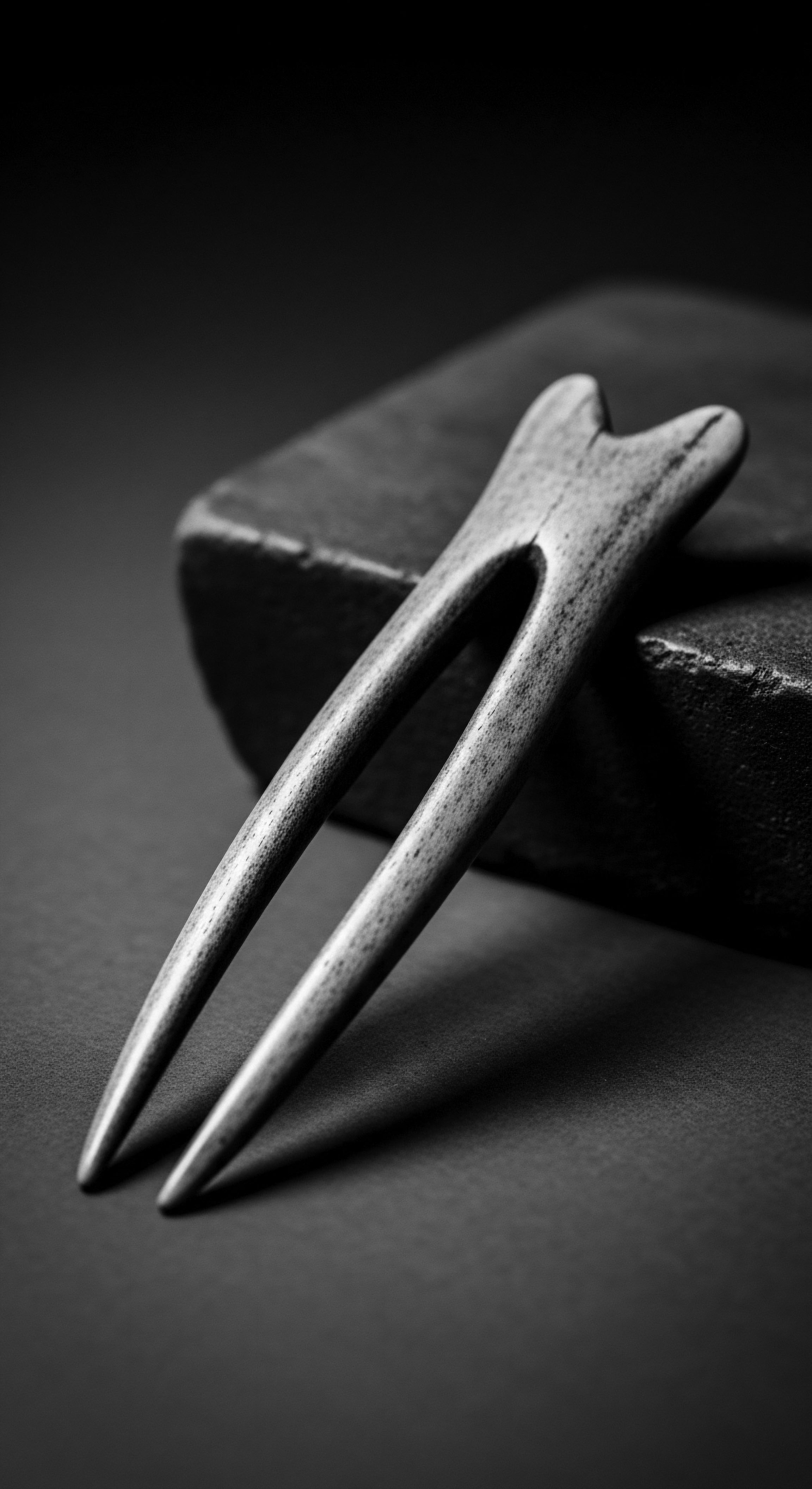
References
- Bain, R. The Science of Natural Hair ❉ A Comprehensive Guide to Healthy Hair. Black Hair Media Publishing, 2017.
- De Groot, A. C. and E. Van der Walle. Dermatological problems from chemical hair treatments. Clinics in Dermatology, vol. 16, no. 5, 1998.
- Herskovitz I, Miteva M. Central centrifugal cicatricial alopecia ❉ challenges and solutions. Clinical, Cosmetic and Investigational Dermatology, vol. 9, 2016.
- Hunter, L. Hair Structure and Properties. Cosmetic Science and Technology, vol. 2, 2001.
- Khumalo, N. P. et al. Central centrifugal cicatricial alopecia (CCCA) ❉ a clinical and histopathological review of 29 cases. Journal of the American Academy of Dermatology, vol. 58, no. 5, 2008.
- Ladipo, Olumide K. Traditional African Hair Care Practices and Their Contemporary Relevance. African Journal of Dermatology, vol. 14, no. 2, 2015.
- LoPresti, P. et al. Hot comb alopecia. Archives of Dermatology, vol. 98, no. 3, 1968.
- Powell, J. M. and D. H. Russell. African Hair ❉ Structure, Mechanical Properties, and Chemistry. Journal of Cosmetic Science, vol. 59, no. 2, 2008.
- Robbins, Clarence R. Chemical and Physical Behavior of Human Hair. 5th ed. Springer, 2012.
- Shetty, V. H. Shetty, N. J. & Nair, D. G. Chemical Hair Relaxers Have Adverse Effects a Myth or Reality. International Journal of Trichology, vol. 7, no. 4, 2015.
- Sishi, V. N. B. Van Wyk, J. C. & Khumalo, N. P. The pH of lye and no-lye hair relaxers, including those advertised for children, is at levels that are corrosive to the skin. South African Medical Journal, vol. 109, no. 12, 2019.
- Warburton, V. The pH of Hair and Skin ❉ What it Means for Cosmetology. International Journal of Cosmetic Science, vol. 18, no. 3, 1996.
